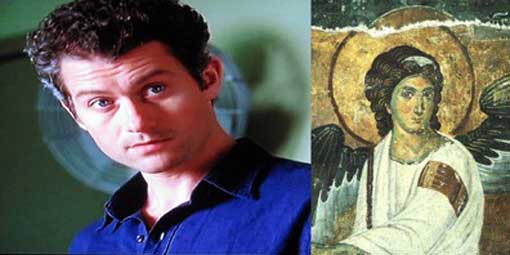
It's always clear when a show is at its top; the directing, acting, styling, lighting and film are all going effortlessly in the right direction. It's a true thing of beauty. And sometimes, editors and directors stay on a shot for a few extra seconds for us (and probably them), to take it all in.
In the case of Rubicon (Sunday at 9 p.m. ET on AMC), those extra seconds may also be something more -- just as covert as the intelligence analysts in their offices, poring over hundreds of pages of seemingly disconnected dots.
Should we be taking a cue from Will Travers (James Badge Dale) and the rest of the API team in New York, and start stitching together our own scraps of leads -- in this case, the vision part of television?
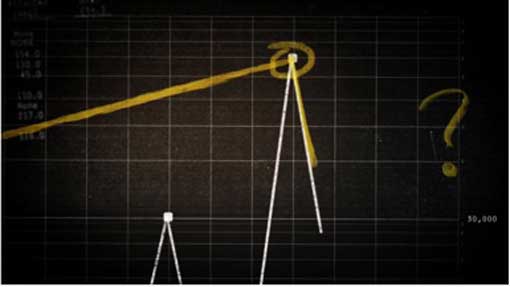
As retired analyst (and possible future victim) Ed Bancroft (Roger Robinson) told Will in Episode 5:
"Our job is to find the dots, connect the dots, then understand the dots . . . the dots are out there in the bits and pieces of information of thousands of signs and symbols that we can pull out of raw data. A man waiting for a bus in Caracas; a woman buying vegetables in an Algerian market; teenagers fornicating in a Liverpool basement. What's the connection? What's the narrative?"
Well, fornicating in a basement aside, I'm Jonesing for any little scrap of narrative that will unlock what the Rubicon conspiracy is all about, and whether or not there is a double agent inside the American Policy Institute (API as it's called, so elite it sees information and surveillance that even the CIA or NSA can't get.)
Since Will and the other API teams must put together the smallest of shreds of electronic data and surveillance, trying to make out patterns of world-wide terrorist attacks in the planning stages, I assume the producers are demanding the same of us. Why should Will and the gang do all the work, sifting through mounds of seemingly unrelated newspaper clippings and phone records?
Shouldn't we be doing our share?
-----
Back in the day, say 17th Century, we got our images in one still shot -- oil paintings. With limited bandwidth, so to speak, artists did a lot of ensemble pieces with separate scenes of action within the frame, needing to pack as much content as possible into one work.
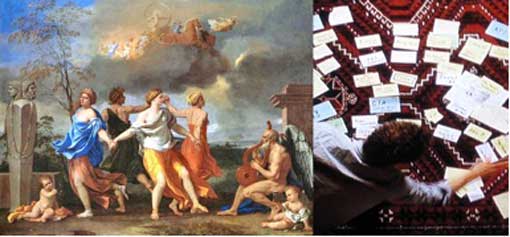
The one here by Nicolas Poussin, "A Dance to the Music of Time" (1640), is recognized for its packed symbols: the four dancers representing the cycle of Poverty, Labor, Industry and Wealth; time running out (the hour glass), the brevity of life (the child's bubble pipe), and the chain of generations (the Janus figure looking forwards and backwards).
(Poussin's "Shepards of Arcadia" (1638) by the way, was conscripted by the Priory of Scion -- the 1950s hoax that inspired The Da Vinci Code -- and that one had a hero symbologist, too, sifting for the slightest hints of meaning.)
So, we fast-forward 450 years to the Rubicon visuals team -- brilliant director of photography Michael Slovis, production designer Tim Grimes, art director Toni Barton. Instead of one shot, we have 10 hours so far of motion pictures. Are they giving us clues, but some only in painterly images, and we're just not seeing them?
Rubicon, if you've been following this enigmatic counter-terrorism drama, tracks Travers as he trips over a conspiracy coded into crossword puzzles published in international newspapers. He begins to suspect that his mentor at API, David Haddas (Peter Gerety), recently killed in a train crash, was murdered. It is revealed that there is a conspiracy at the highest levels of API -- seven childhood boys in a photo that keeps turning up, and two of them have committed suicide after receiving a four-leaf clover, the sight of which triggers some pre-programming in them to make them do it. So much for a lucky clover, and someone's idea of the cruelest irony.
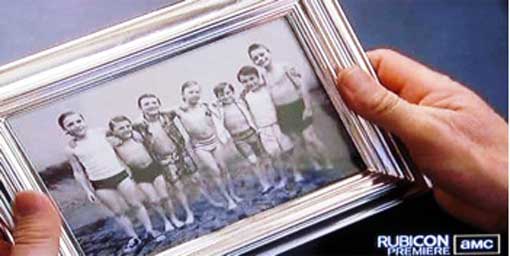
TVWW's Fearless Leader, David Bianculli, recently wrote "it's not paranoia if it's actually happening." And it is happening: the odd, speech-affected Director of API, Truxton Spangler (played superbly by Michael Christopher), is clearly in the now grey-haired group of boys that seems to be involved in some sort of world-wide profiteering based on market swings in politically volatile regions, and their ability to know what's happening in advance. Spangler's a major player, bugging an owl statue in Will's office. (And in case you missed that connection, Will ought to fear the bald character, the night predator.)
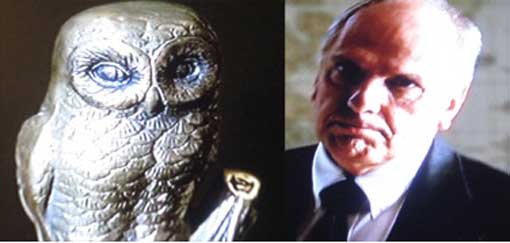
Angels appeared regularly in medieval paintings with halos, usually a gold dish of light silhouetting the head. In one recent episode, in the API conference room, Will had a virtual halo (a wall mounted fan) around him. (See at the top of the article.) Maybe it's safe to say that Will's not playing anyone, and he really is only trying to figure out what really happened to his mentor Haddas, and won't turn out to be some sort of double agent.
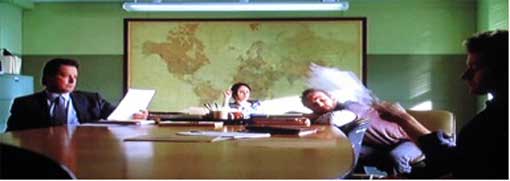
And speaking of double agents, is Tanya McGaffin (Lauren Hodges) one herself? She has a drug addiction problem, a Russian name, somewhat extremist tendencies, and she might just be troubled enough at ordering predator strikes, and not having the talent of Miles Fiedler (Dallas Roberts), to want to sabotage the whole order of things.
It's been made clear that whoever hacked into API's network would virtually hold the keys to the free world, the information there is so sensitive. By recent episodes, Tanya has wedged herself to the center seat of the conference table, at the center of the map of the world, while Miles and Grant are below the line of the painted wainscot. Is Grant (Christopher Evan Welch) really in the dark? Will Miles (Dallas Roberts) be the one who solves the mystery?
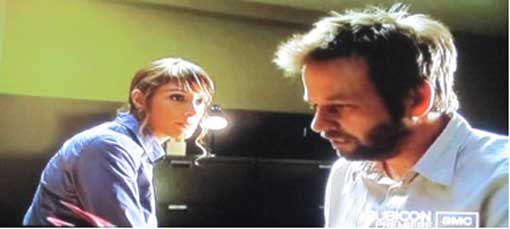
Above is Miles as rabbi with his pupil, Julia (Natalie Gold). Julia appears in this scene with the long curling sideburns of the rabbinical student. This is the second scene where we've seen Miles with one light behind him -- is he the one, true, incorruptible light who will expose the conspiracy?
And what about Will's courtyard Rear Window admirer, Andy (Annie Parisse), the painter in the tank top? Is this a sign that a female -- in a male symbol of brute power -- is somehow involved and against Will? If the double-agent is female (like one of their assassinated suspects, Tanaz, whom they were tracking through the Middle East), maybe it's Tanya. (The character of Maggie seems less likely a threat, although she's been twice seen in "spy wear.")
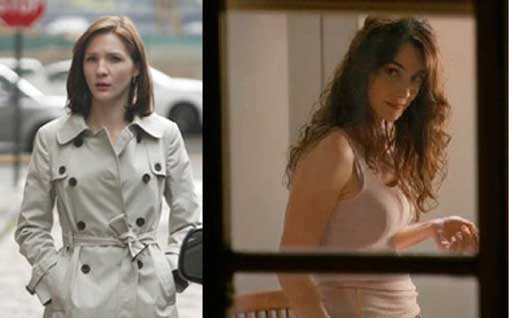
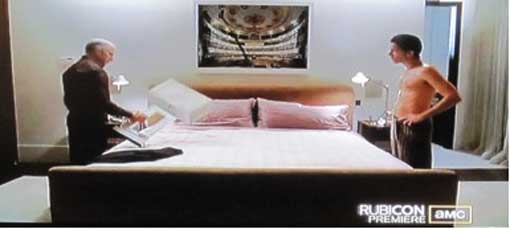
And what of Kale's live-in partner Walter? Last week we saw them in the bedroom, at the center stage of the opera-drama painting on the wall. (Also, the shape is evocative of a coliseum, a venue for one-on-one combat.) Kale found a bug in a lamp on the roommate's side. Again, Spangler will use all available techniques, and Kale could be sleeping with the enemy, or is Walter being "framed" as when he was shown against the other painting in the room?
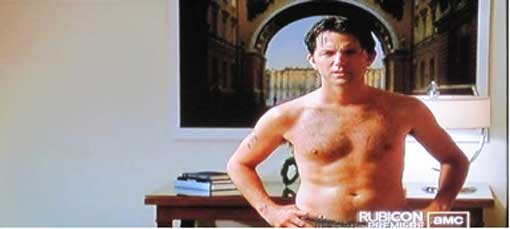
Will's immediate boss, the gym-coiled ex-field assassin Kale Ingram (another fantastic performance by Arliss Howard), is clearly playing both sides, not revealing what he knows but trying to steer Will in the right direction. Kale speaks in cryptic puzzle-hints to Will, just giving him enough information to get to the next step.
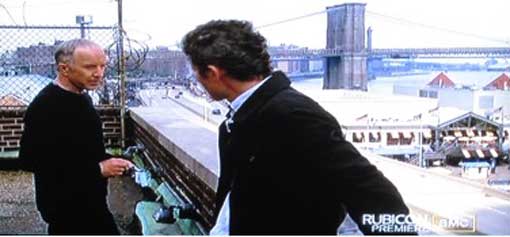
It's clear he's playing both sides. (He's shown in front of bridges a lot, and once, against snarled barbed wire on the roof of API.) Will his life as a former operative and assassin finally catch up with him, as the decapitating "head shot" taken in Spangler's office shows?

Or, maybe he's a pawn of Spangler's as well, as seen when Will is in Kale's loft, with the Red House artwork, perhaps a clear warning sign that Will's in the wrong place at the wrong time.
Bridges play an important graphic element. Kale's been connected to Will in front of the Brooklyn Bridge, and also with Maggie (Jessica Collins). Last week, we saw Will with Katherine (Miranda Richardson) connected in the same way, so maybe it's safe to say at this point that all of the characters are joined, probably on the side of the moral and good, and we should be looking to the other characters for the real villains.
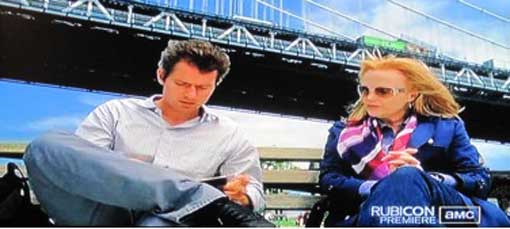
The secrets of Rubicon are many. Are the "Clover Group" (the Seven Boys) simply war-time profiteers, or is there something more? Has a double agent compromised API? What side is Ingram really on? Where will the next terrorist strike be? Is everything connected somehow?
As his predicament deepens, Will can't presume to trust anyone, and must alone outwit the whole thing. Spangler has warned Ingram that Travers will be dealt with, "as all problems are." (Also clear, just by a wince and a muscle twitch, Ingram really does fear Spangler. An amazing moment.)
-----
All of these characters have been fascinating and well developed, all having "crossed the Rubicon" (point of no return) in some manner because of the nature of their work in counter-intelligence. They've all sacrificed personally and morally to do the work they do.
I will be disappointed if the elders at API are merely going rogue, kicking it Cheney-style, because they are all-powerful, jaded cold-warriors trying to go back to the good old days of the post-war military-industrial complex. I feel like the writers have been too smart and too original for that.
Hopefully, the eventual conclusion will be as timely as the other plot references have been, and we will indeed learn something new from this small, humble piece of fiction.
It's hard to imagine where Rubicon will go from here if it returns, the scope and depth of its inaugural year being so finely crafted. (The ratings have been low, and there is an email campaign being devised to get the attention of AMC decision-makers.)
Season 1 is going to be a tough act to follow. The best part of Rubicon is that it doesn't rely on explosions, grisly murders or stock Hollywood psychos stalking the female leads. It simply takes ordinary daily life, and turns it into something steeped in danger, which is quite an analogy for times wrapped in terror and economic upheaval.
My sense is this season of Rubicon will have gravitas as lasting as such venerable TV works as Homicide, Six Feet Under, Pennies From Heaven (Dennis Potter's 1978 version) and others. It's just too well written, too well acted, too well directed not to get the true consideration it deserves. Let's hope so, even though the Emmys are light years away next summer. When people are working this well, they deserve recognition.
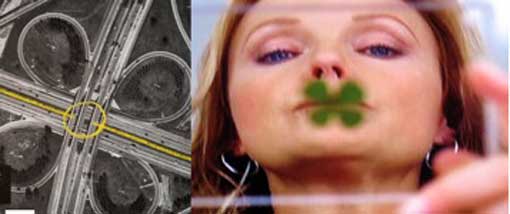
And what about the four-leaf clover? Will's clues from the crossword puzzles say it symbolizes a secret, fourth branch of Government. I leave nothing uncovered, including the old song I learned in grade school.
Yes, conspiracy friends, I learned the first clue as a young boy, just like the Gang of Seven in the photo by the lake. Now, is it someone that Will adores? Kale? Truxton?
It's still a mystery.
I'm looking over a four-leaf clover
That I overlooked before
One leaf is sunshine, the second is rain
Third is the roses that grow in the lane
No need explaining, the one remaining
Is somebody I adore
I'm looking over a four-leaf clover
That I overlooked before
-----
For more clues, visit AMC's Rubicon site.